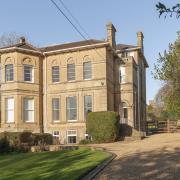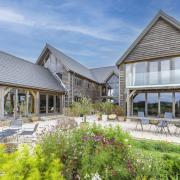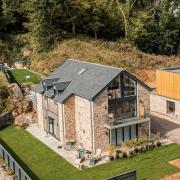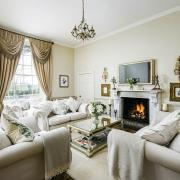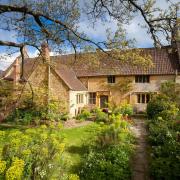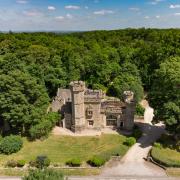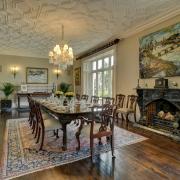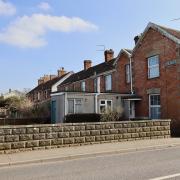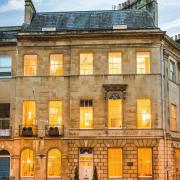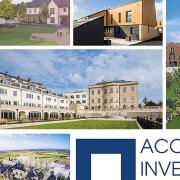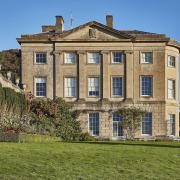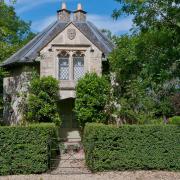Every house has a history, some more so than others, but as Catherine Courtenay discovers, it’s very often the homeowners themselves who create its unique identity

Myles and Shelagh Wickstead are travellers and have spent many years living abroad, both before they met and throughout their subsequent married life; but they’ve always felt that The Manor House at Norton-sub-Hamdon was their true home.
I meet the Wicksteads for coffee in the secluded walled courtyard to the side of The Manor House; with the sound of birdsong and the water fountain, and surrounded by the honey coloured stone walls of the house, it’s a dreamy spot in which to sit.
We then walk around to the front garden and, looking up at the honeysuckle and wisteria-clad property, Myles points out the various sections, tracing its history back through the generations. There’s a wing built in 1910, an 18th century top floor and a Tudor section at its heart. It’s hard to spot the changes to the building, as each addition appears to have been sensitively built to blend in with the original.
Before going inside we visit the treehouse. It’s hidden away, high up in one of the mature trees at the back of the garden. Sculpted around the trunk and branches it speaks of childhood adventures - and no doubt a few summer evening drinks on its balcony. It was made for the family by a local builder who used ideas taken from his time living in Africa.

It’s a fitting connection because the Wicksteads also have strong links to Africa; Myles’ long career in the Foreign and Commonwealth Office included several years as British Ambassador to Ethiopia, Djibouti and the African Union.
Up the path, across a sweep of lawn, we enter through the low-key front door and arrive in the hall, at the heart of which lies an original old fireplace. It’s a perfect house for Christmas parties, Shelagh tells me and yes, with its stone floors, beams strung with dried flowers and generous proportions, it’s easy to picture a celebratory festive scene.
It was Myles who first discovered the house. The couple, who were in Kenya at the time, had wanted to find a home in the country, somewhere a bit nearer to Myles’ parents.
At that time the manor was split into four flats, a change which had taken place under a former owner in the 1950s. Myles had seen one of the flats advertised in the back of a newspaper and went to investigate. Smiling, he says he’ll never forget the day he arrived in the village.

“I drove down, and had half an hour spare so I drove up towards Ham Hill and saw a couple of foxes playing in a field.”
Shelagh says she could hear the excitement in Myles’ voice when he called to say that he’d found the perfect place.
It was 1995 when they moved in and over the subsequent years they gradually acquired extra sections of the house.
Spread over three floors there are plenty of passages and rooms to explore and all the rooms are surprisingly spacious, it doesn’t feel like a house that was constricted to make separate living areas. Its history is ever present with the fireplaces, Georgian panelling and plentiful window seats. And the Wicksteads have left their own legacy, adding to the story of this house – Myles compiled the Government’s 1997 White Paper on world poverty from his study at The Manor House.

Although pleasing to see it as one complete building again, there are plenty of opportunities to create separate living spaces. The final piece of the jigsaw fell into place when the Wicksteads bought the last flat which occupied a central area on the first floor. Apart from taking out an old kitchen the couple have left it untouched and it’s ripe for an exciting project. All the rooms contained within are big and one in particular has a beautiful old fireplace with windows looking out across the grounds. It must have been a very grand Tudor room at one time.
After exploring the house we go back to the garden and behind a yew hedge (which is old enough to be listed) there’s another huge lawn.
The couple recall a happy memory of a party, when they had 90 people staying for a weekend, 30 in the house and the children camped out on this lawn.
Despite their travels, which included a period of time living in the United States when Myles served on the Board of the World Bank, the couple, and their children Edward and Kathryn, see this place as their home.

“The children knew that Norton was their home,” says Shelagh. “I definitely wanted them to go to the village school – Edward was known as ‘the American boy’. He was always thrilled to bits to come home and go to the village school for a month at a time.”
We finish with another coffee and the couple talk about the early days when they’d come back to The Manor House for the weekend and would sit in the courtyard, catching up over a glass of wine with their neighbours who lived in the other flats.
Now that Edward and Kathryn have left home, they want to move on, but will it be hard to leave this house?
They confess that they couldn’t live anywhere else in the village, such is their personal attachment to The Manor House.
It’s time for further travels for the Wicksteads, but in The Manor House they’ve left a new adventure for someone to explore.
Also...
On October 27, 1914 The Manor House was opened, with just a few hours notice, as a hospital for wounded Belgian soldiers. Initially there were 20 beds and the community rallied around to help, as with only 2/6 per day given by the War Office for maintenance, there was no other financial help.
Helpers came in from the village to wash up, mend clothes and do laundry.
The last Belgian patient left on July 5 1915 but from 3 April that year wounded British troops started to arrive and the hospital was enlarged to 35, then 50 beds. The panelled dining room was used as a recreation room and there are photographs which show patients playing croquet on the lawn.
The hospital closed on January 17, 1919. A total of 412 patients had passed through its doors, of whom only one died and was buried at the village church.
The Manor House at Norton-sub-Hamdon is for sale at £1.35 million. Enquiries should be made to Ashley Rawlings at Savills Wimborne on 01202 856 800.



